Does your pool look like it’s seen better years? Do you see signs of wear and tear? Feel like it could use a new look?
If your answer to these questions is yes, then your pool needs to be resurfaced. Pool resurfacing is the process of removing your pool’s old surface to apply a new one, be it plaster, quartz, pebble, or tile. Pool resurfacing offers a slew of advantages including improved structural integrity as well as the option to update your pool’s aesthetic quality.
But how much exactly does resurfacing a pool cost, and, is it worth it?
In this article, we’ll talk about pool resurfacing and everything that affects the costs of this important undertaking. But before we begin, let’s take a moment to understand what pool resurfacing is and why many pool owners and pool contractors think it’s so important.
What is Pool Resurfacing?
As we’ve briefly covered above, pool resurfacing is the process of removing your pool’s old surface in preparation for applying the new interior. Pool owners often have their pools resurfaced to help address structural damages like cracks on the pool’s walls and floors, as well as aesthetic issues like stains and discoloration of the old surface.

But here’s why it’s so important.
Your pool’s surface is not meant to last forever. In an ideal environment for a residential pool, pool plaster will last for a good 7 years while pool pebble can last for as long as 15 to 20 years. And while the first signs of damage, like hairline cracks, can be addressed by patching solutions, it will eventually require a more concrete rectification.
That said, pool resurfacing offers a more lasting solution and allows contractors and pool owners to address almost all issues related to their pool’s interior. Although it’s not a be-all-end-all answer to problems you have with your pool’s interior, it’s as close as you can get to a brand-spanking-new pool.
“As close as one can get to a brand-new pool,” well, that sounds expensive? Depending on how you look at it, it could be cheap or costly.
The national average cost of pool resurfacing is around $6,500 for a 1,000 square foot pool. However, these numbers may vary depending on several factors, and here are a few.
Types of Pool Resurfacing Materials
Before your project begins, your pool contractor will usually help you with selecting the type of material to use for the pool interior. The better the material is, the more expensive it gets. Your contractor will usually offer three types of material; plaster, aggregate, and tile. Here’s how they stack up.
1. Plaster
Pool plaster is one of the most common materials used for pool interiors. It’s usually made of white Portland cement and marble dust with variations of colors through the use of additives, which helps produce different shades to match the aesthetic quality of your pool.
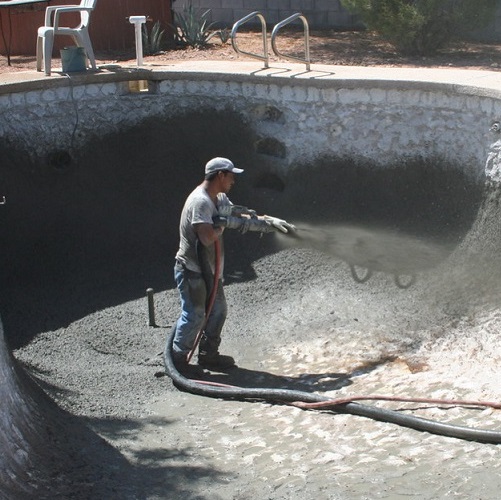
Pool plaster is one of the most affordable materials and will cost an average of around $5,000 to $5,500 for a 1,000 square foot residential pool. While it may be an affordable option, the average pool plaster usually lasts for 7 years until the plaster will have had weakened and shown signs of wear and tear. That said, attention to care and maintenance must be observed to keep pools lined with plaster in good condition.
Is it worth it?
The fact that a lot of pool owners still use this kind of material as of this day only means that it’s worth investing in plaster for when you want your pool resurfaced. As it happens, many pool owners and pool contractors do recommend the use of plaster for those who are working on a tight budget. It’s an affordable and practical means of resurfacing your pool with a few benefits to offer. If you’re on the fence whether to use plaster or not, consider checking out its advantages and disadvantages.

Pros:
- Affordability – As we’ve covered above, pool plaster is one of the cheapest types of materials used in resurfacing your pool. It’s widely available and can easily be prepared and applied to the exposed concrete.
- Aesthetic Appeal – Pool plaster offers a beautiful aesthetic appeal amidst its simple and bland look. White plaster creates a fitting backdrop that gives your pool a brilliant, clear, light blue appearance.
- Functionality – It’s easier to spot stains in white plaster. It’s also easier to see if someone is in need of help with a white contrasting background making white pool plaster the ideal finish for families with children and elderly in the household.
Cons:
- Durability – With swimming pools, you get what you pay for. Because white pool plaster is the most affordable option, it does not last as long as its more expensive counterparts. As we’ve briefly covered above, pool plaster only lasts an average of 7 years compared to pool pebble that boasts an average of 15 to 20 years. Furthermore, proper care and maintenance, especially to your pool water’s chemistry, must be observed.
- Texture – pool plaster can also be rough. The surface of the plaster is porous and the small microscopic can swell, bloat, and bulge over time. It can feel rough to the touch and may even damage swimsuits. It can also harbor unwanted microorganisms and pathogens.
- Dated Look – While pool plaster offers a simple aesthetic appeal, today’s pools are moving towards a more modern style and the classic pool plaster has started to look more out of place in most modern homes.
2. Aggregate
Pool contractors will often refer to finishes like quartz and pebble as aggregates. They are the modern version of plaster and uses either glass beads or pebble stones instead of sand or marble dust. This creates more texture and a lasting finish, which makes aggregates a more expensive option when resurfacing your pool.
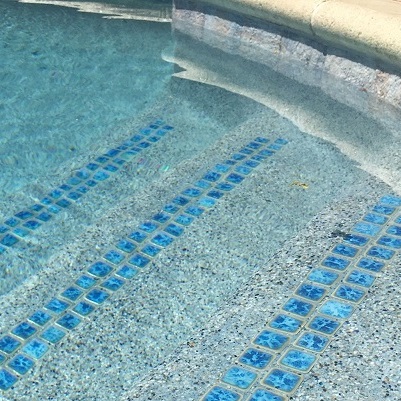
Aggregates will range anywhere from $6,000 to $9,000 for pools that measure around 1,000 square feet. Because they use more hard-wearing material like quartz and pebble, they offer better durability ad longevity compared to plaster. Pool pebble will last an average of 15 to 20 years under ideal conditions. They also require less maintenance because these types of finish can hold up well against heavily treated pool water.
Is it worth it?
Aggregates make for a better pool interior despite its somewhat larger upfront cost. They last longer than pool plaster and require less maintenance. They stay beautiful and are less susceptible to stains.
Here are some pros and cons of using aggregates.

Pros:
- Longevity – It’s no secret that aggregates like quartz and pool pebble last longer than the average plaster. You don’t always have to worry about resurfacing your pool every now and then. You can make do with brushing your pool’s walls, steps, and floors as aggregates aren’t as hard to maintain as plaster. They don’t stain and chip as easy and is more resistant to pool chemicals like chlorine.
- Customizability – Aggregates come in various shapes and colors and can either help give your pool a cohesive look or make it stand out. Aggregates like pebbles are perfect for backyard pools with concrete decks lined with natural stone tiles. Whether you give emphasis to your pool’s cool and inviting waters or highlight its warm rustic look, you’re sure to find aggregates that will help you achieve a customized look.
- Functionality – Because aggregates add dimension and texture to your pool interior, they can also provide some kind of traction so you don’t slip and fall into the pool. Some aggregates can be smaller so they won’t hurt your feet while making your pool safer and easier to swim in.
Cons:
- Expensive – Using aggregates won’t cost you an arm and a leg, but is more expensive than plaster. That said, you’re getting what you pay for as aggregates can look as good as it lasts.
- Surface Texture – When using aggregates for your pool interior, it’s best to talk to your pool contractor about what you like and what you don’t like in your pool. As an example, larger pebble stones will feel coarse to the feet and might be difficult to walk on overtime. On the other hand, other varieties of pebbles with smaller stones may be a better choice.
3. Tiles
Considered as the most expensive option when it comes to resurfacing your pool, pool tiles exude an air of elegance and sophistication you simply can’t find in plaster nor in aggregates. Pool tiles are specially designed to handle the chemicals and the pressure of the pool water and can last a long time.
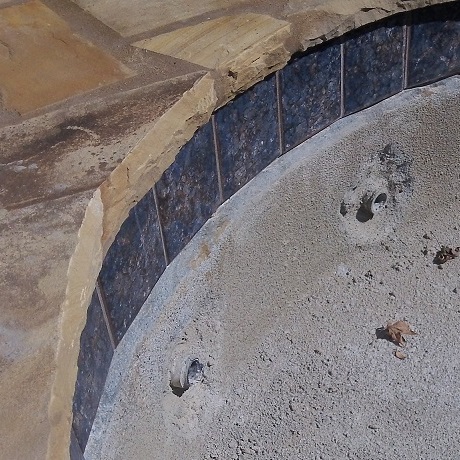
The costs of pool tiles can go as far as $30,000 and is considered a premium finish for swimming pools. When maintained properly pool tiles last longer than aggregates and average around 20 to 25 years. They are easier to clean and are resistant to common pool stains. They provide a smooth finish so you won’t have to worry about hurting your feet or damaging your swimsuits should you swim near the walls of your pool. They are highly decorative and allow for endless possibilities in terms of style and design.
Is it worth it?
If you have the money, using pool tiles is definitely worth it. It not only elevates the aesthetic quality of your pool, but it also increases the value of your home and our property. Here are some things to consider when choosing pool tiles as an interior finish for your lavish private pool.

Pros:
- Personalization – No other material offers the level of customization as pool tiles. You’re no longer limited to just colors, but can now play with a wide range of designs especially when using mosaic tiles. The versatility in terms of design makes pool tiles one of the best choices for pool owners who want a truly unique slice of aquatic haven.
- Aesthetic Quality – Pool tiles can help take your pool to a new level of beauty. Tiles have a reflective quality that creates the ideal background for a pool that shines and sparkles. That’s why luxurious hotels often invest in lining their pools with tiles as they allow the water to complement the pool’s design and emanate opulence and sophistication.
- Longevity – As we briefly covered above, pool tiles last the longest when installed properly and are relatively resistant to pool chemicals that can otherwise weaken plaster and aggregate. Plus, pool tiles make cleaning and maintenance easier. Brushing or wiping the surface can help remove minor stains because of the pool tile’s smooth yet durable surface.
Cons:
- Costs – Pool tiles are expensive. The average cost of a glass tile can range anywhere from $75.00 to $100.00 per square foot installed. That said, other pool owners use tiles only for the pool’s waterline, steps, benches, and in the shallow areas of the pool to help create a focal point instead.
- Requires a Professional – Installing pool tiles can be tricky, hence, it should be carried out only by an experienced professional. Pool tiles require a special kind of grout that can withstand the pressure of the pool water against it and when done incorrectly, the tiles can break and crack easily. That said, it’s no DIY project and you wouldn’t want to be making any expensive mistakes.
Other Factors to Consider
Although the materials you choose when resurfacing your pool greatly affects the overall cost of the project, several other factors also contribute to the total cost of updating or repairing your pool through resurfacing.
Here are a few.
1. Method of Removing the Old Surface
Just like in any other undertaking, prep work matters. That said, it’s important for the pool’s interior to be removed properly and different contractors will have different methods of removing the old pool surface. In some cases, the variations in how the old surface is removed can affect the overall cost of resurfacing your pool.
There are several methods of taking out the old surface, however, two of these methods stand out. These are the chip out method and the hydroblast method. Here’s how they’re different.
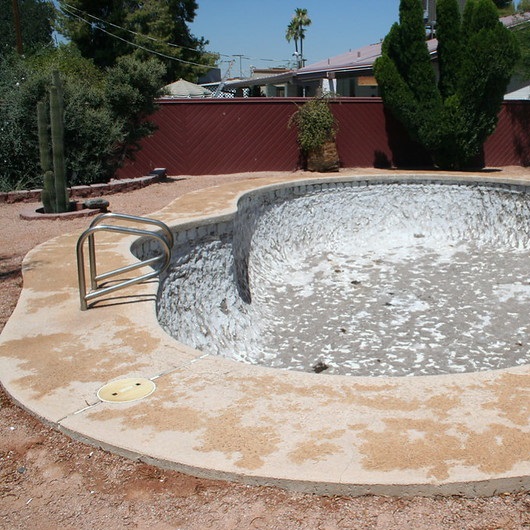
The chip out method is carried out using power tools like jackhammers and hand tools like mallets and chisels. Chipping the old pool surface using these tools allows your pool contractor to have more control over how much of the old interior is removed. Experienced pool contractors can remove just the right amount of the old surface without exposing the rebars in the concrete. Exposing too much of the concrete, let alone taking out big chunks of it, can cause serious problems from unevenness to the weakening of the structural integrity of the pool. It also requires heavy labor that’s why in most cases, the chip out method is more expensive compared to the hydroblast method.
Here are some of the pros and cons of chipping out the old surface.

Pros:
- Allows contractors to remove more of the old surface.
- Ideal for repairs as your contractor can chip out as much surface as needed.
Cons:
- Can damage the pool if not done properly.
- Can cause other problems if not carried out properly.
On the other hand, hydroblasting the old surface requires the use of a water blaster to strip the interior. By cutting the old surface with high-pressure water, hydroblasting evenly removes the old surface although it only removes a thin layer of the old interior. The whole undertaking can be carried out with a small crew and requires minimal labor as the process is carried out with the aid of a water blaster.
Here are some of the pros and cons of hydroblasting.
Pros:
- Evenly removes the old interior.
- Does not damage the structural integrity of the pool.
- Does not cause trauma to the pool shell.
Cons:
- Can only remove a thin layer of the pool’s old surface.
Your contractor usually suggests which method to use depending on the circumstances including the severity of the repair and the type of material that needs to be applied over the exposed concrete. Plaster requires only a thin layer of the old surface to be removed while aggregates like large pebble stones, quartz, as well as tiles might need more of the old surface removed to make sure the new interior sits flush with the tile surface.
2. Location.
Your pool’s location can also affect the cost of pool resurfacing. Pools in the northern states tend to have more expensive costs when it comes to pool resurfacing. The reason behind this is that states with warmer climates tend to have more homes with pools and as a result will have more pool contractors in the area. This means that there will most likely be more suppliers in warmer areas that those in colder locations. Consequentially, contractors will have to ship out the materials which increase the overall costs of resurfacing a pool.

So, here we have it. The most common factors that affect the cost of resurfacing your pool and just how much of an influence they have on the project. Make sure to keep an eye out of these things so you can make a better decision when planning on your next pool renovation.

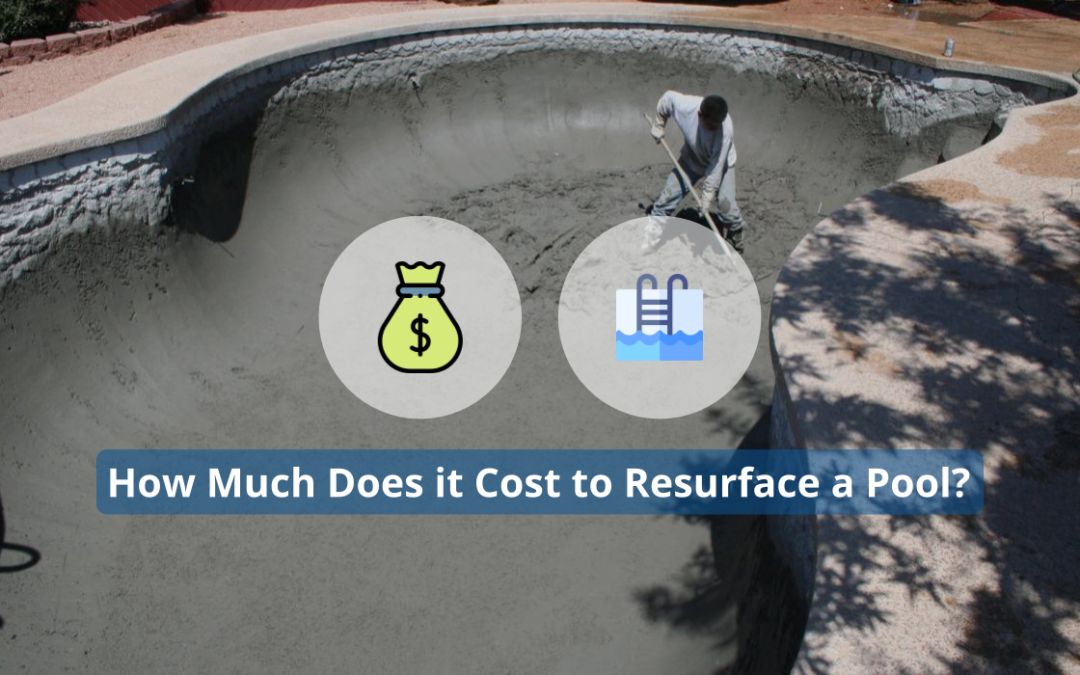
Greate article. Keep posting such kind of information on your site. Filia Errick Gereld